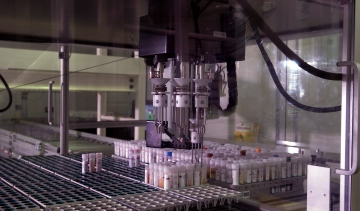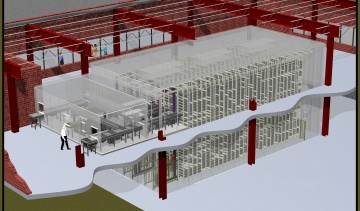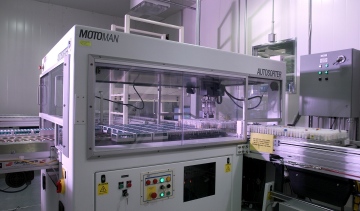
Passing the test in a hurry
By Jim McMahon
Automation ARUP laboratoriesAs one of the largest medical testing laboratories in the United States, ARUP Laboratories is naturally a highly automated facility. Headquartered in Salt Lake City, Utah, the Associated Regional and University Pathologists, Inc. (ARUP) is home to one of the world’s largest clinical laboratory freezers—operating at -20°C—outfitted with a two-storey AS/RS (automated storage and retrieval system that can hold up to 5,220 stainless- steel storage trays of specimens on indexed shelf locations, with total capacity of over 2.3 million individual specimens.
As one of the largest medical testing laboratories in the United States, ARUP Laboratories is naturally a highly automated facility.
Headquartered in Salt Lake City, Utah, the Associated Regional and University Pathologists, Inc. (ARUP) is home to one of the world’s largest clinical laboratory freezers—operating at -20°C—outfitted with a two-storey AS/RS (automated storage and retrieval system that can hold up to 5,220 stainless- steel storage trays of specimens on indexed shelf locations, with total capacity of over 2.3 million individual specimens.
At the heart of the operation is a highly-automated sorting and transport system consisting of two Motoman robotic sorters—used to and unload finished specimens into storage trays—and continuous-flow Shuttleworth “smart” conveyors, which jointly retrieve and transport specimens for clinical testing in less than 2.5 minutes, with a capacity of handling 4,000
specimens per hour.
Formed in 1984 as a national clinical and anatomic pathology reference laboratory and a wholly-owned enterprise of the University of Utah’s Department of Pathology, ARUP today employs over 2,500 people and offers in excess of 2,000 tests and test combinations—ranging from routine screening tests to highly esoteric molecular and genetic assays.
Billing itself as a role model for bridging the gap between academic medicine and successful business enterprise, ARUP was not always the showcase of precision automation and high-volume, efficient laboratory specimen handling it is today, according to George Falk, project specialist at ARUP’s Central Support Services Group.

A reader mounted onto each of the Motoman robot’s six grippers instantly gathers all the important information from the attached barcodes as the tubes are being rotated into proper positions.
“Before the arrival of automation, ARUP was using walk-in freezers at three different locations to store specimens,” recalls Falk. “The samples were stored manually in cardboard trays, with a capacity of about 400,000 specimens.
“To find a sample, a lab technician had to go into the walk-in freezer with a box number (an X/Y reference) and search manually, and the personnel were required to enter the freezer in pairs for safety reasons, wearing coats—making looking for a specimen a fairly labor-intensive and time-consuming process.”
Because of ARUP’s esoteric testing environment—whereby more than 1,000 different tests comprise 80 per cent of its test volume—the amount of small-batch tests handled by ARUP required an urgent automation overhaul, relates Falk, to eliminate of excessive handling and sorting; improve the tracking, storage and retrieval of specimens for repeat or additional testing; and enable real-time communication among all of ARUP’s laboratory related software systems.
The lab’s upgrade commenced with installation of a proprietary ARUP software system called ESP (Expert Specimen Processing) to facilitate rules-based automation of its specimen processing, along with enabling automated storage of specimens and complete specimen tracking.
The initial computer input of the specimen information is done in the doctor’s office and assigned a barcode, explains Falk, which is then logged into the ESP software.
Even before the sample arrives at ARUP, all of the specimen’s data—where it is going and what needs to be done with it—is made available in real time, and the ESP then tracks the specimen with laser scanning of the attached barcode throughout its entire life-cycle within the system.

A schematic representation of the ARUP facility in Salt Lake City, equipped with a state-of-the-art ASRS assembly that allows for storage of up to 2.3 million inidvidual specimens at any one time.
To optimize its sample processing and tracking capabilities, ARUP adopted a 5-ml standardized transfer tube which fits into the system’s transport carriers and is tracked through ESP throughout the system.
Falk says that using ESP and standardized tubes helped optimize the world’s first automated thawing and mixing workcell that thaws and mixes frozen specimens while in transport at a rate of more than 1,000 per hour—allowing specimens in the transfer
tubes to be thawed in 30 to 40 minutes, instead of the typical frozen urine samples requiring five to six hours to dethaw in 90-cc bottles.
Falk says that an automated transport and sorting system—enabling rapid transport to and from the specimen processing area
and high-speed sorting of tubes into a large number of different sort groups—expedites even the most remote specimen from the
processing workstation to the further-located robotic sorter in less than eight minutes, conveyed on a 1,100-foot-long linear track.
“The continuous flow of specimens to the robotic sorters, which are located near the laboratory area, has eliminated considerable walking from the lab to where the specimens are processed,” relates Falk. “Prior to the implementation of ARUP’s automated track system, a typical specimen was manually sorted at least three times, and handled seven to nine different times, prior to testing.”
Designed and built by Motoman, Inc., the system’s two high-throughput AutoSorter robots are attached to the automated track system to automate the transfer of tubes from the automated track system into storage trays or racks for entry into the freezer for storage.
Whenever a sample is recalled for testing, the AutoSorter receives the storage tray or rack—trays used to store tubes in higher-volume storage categories and racks for lower-volume categories—which is quickly conveyed out to the requesting lab technician.
A reader mounted on each of the robot’s six grippers reads barcodes as the tubes are rotated by the robot—eliminating the need to orient the barcodes—with the AutoSorters able to sort up to 2,000 tubes per hour into user-definable targets.
The AutoSorters are positioned within a large refrigerator, maintained at 4°C, which located at the front of the freezer—serving as an anteroom to the freezer. When the automated doors to the freezer are opened to allow trays to go in or out, the environmentally-controlled humidity of the refrigerator ensures that condensation does not form on the outside of the specimen tubes, which would inhibit reading the labels and barcodes on the sides of the tubes.
A PC-based control system used to control the AutoSorters communicates directly with the ESP to obtain specimen data— improving traceability and eliminating sorting errors, while passing sort results passed back to ESP to maintain full traceability of the specimen at all times.

Smart conveyors entering and leaving the freezer feature innovative Slip-Torque technology to achieve low back-pressure accumulation in order to minimize any potential product damage.
Specimen trays entering into the refrigerator through the AutoSorter robot cells need to be precisely positioned for the robot grippers to contact the specimen tubes before releasing to the AS/RS in the freezer for archiving.
Likewise, specimens exiting the freezer from the AS/RS must again be precisely positioned for exact placement of the AutoSorter robot grippers in the refrigerator before releasing them to the laboratory.
This is accomplished through a specialized system of continuous-motion input and output roller conveyors—manufactured by Shuttleworth and integrated with product stops, pushers, clamps and other devices, mounted below the surface, to modify the flow of the tubes.
The conveyors boast Shuttleworth’s proprietary Slip-Torque technology, which minimizes sample damage by creating low back-pressure accumulation—allowing the low line pressure throughout the continuous-motion accumulation conveyors to execute precise product placement with the AutoSorters.
The conveyors can continue to take product flow from the upstream line for a period of time instead of stopping, while a low-pressure accumulation buffer absorbs irregularities in the production flow, and provides a smooth, even flow on the line.
The Slip-Torque solution utilizes individually-powered rotating roller shafts and loose-fit rollers, which become the conveyor surface, powered by a continuous chain to control the drive force for the samples.
When the samples stop on the surface of the conveyor, the segmented rollers beneath them also stop—generating low back-pressure accumulation and minimizing sample damage.
The innovative Slip-Torque system is designed to allow the same conveyor to be split into three independently-operating lanes, so that the middle lane can accumulate while at the same time, the right and left lanes continue conveying.
Although each lane can act independently, the entire system is powered by only one motor, according to Falk, helping reduce energy costs.
Once the Shuttleworth system conveys and positions a master rack and a series of sample trays, the robotic cell transfers specimens from the master rack to the assigned sample trays—depending on what tests or diagnostics are to be preformed.
“The tracking of the specimen has improved greatly with automation,” sums up Falk.
“Not only do we know always know where the specimen is., but there are also significant labor and time savings as well, and the system is much more convenient to use.”
Jim McMahon is a U.S.-based writer specializing in industrial automation technology.
Photos courtesy of ARUP Laboratories.
Advertisement

